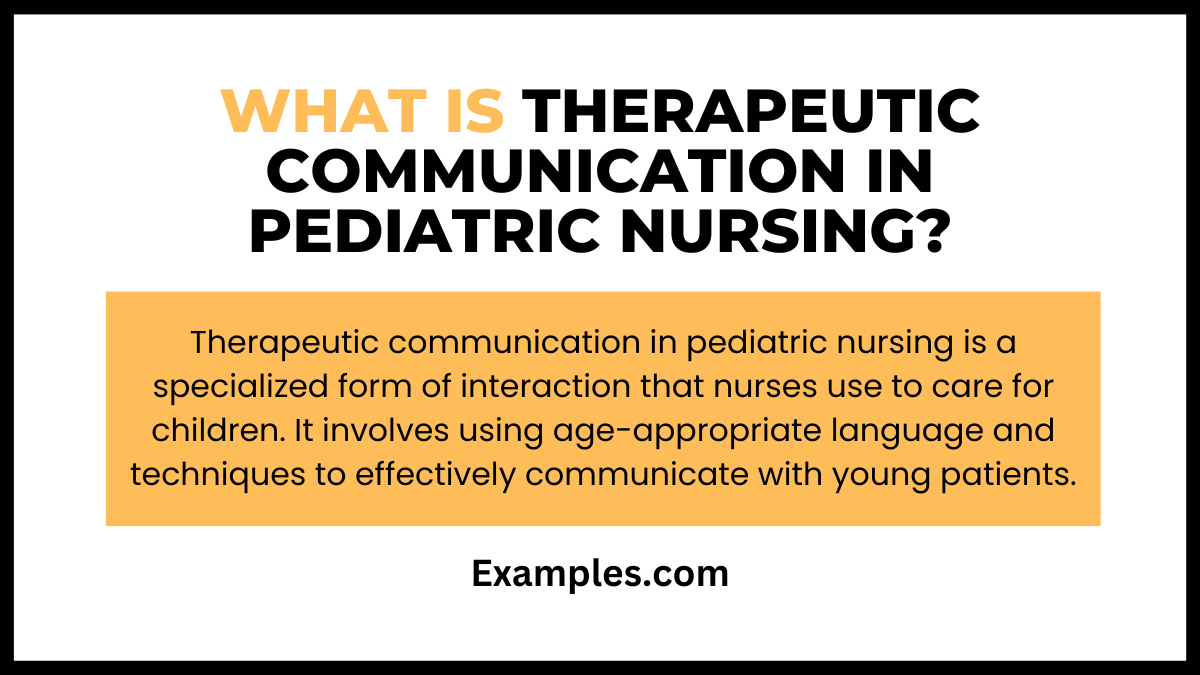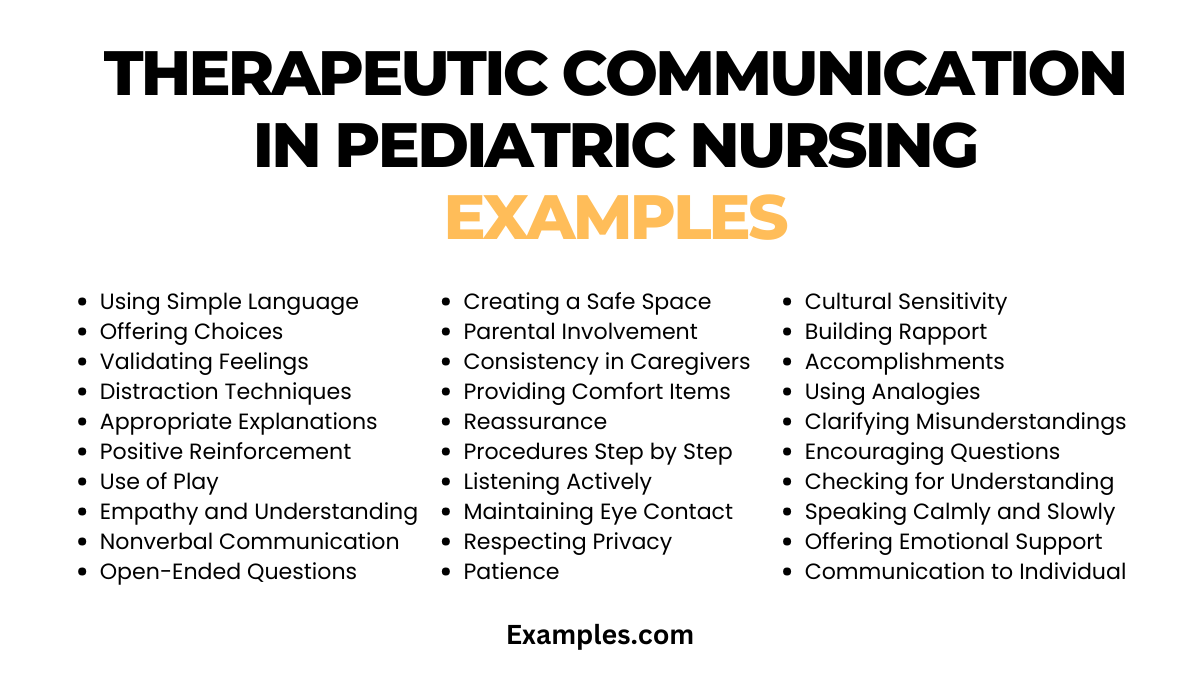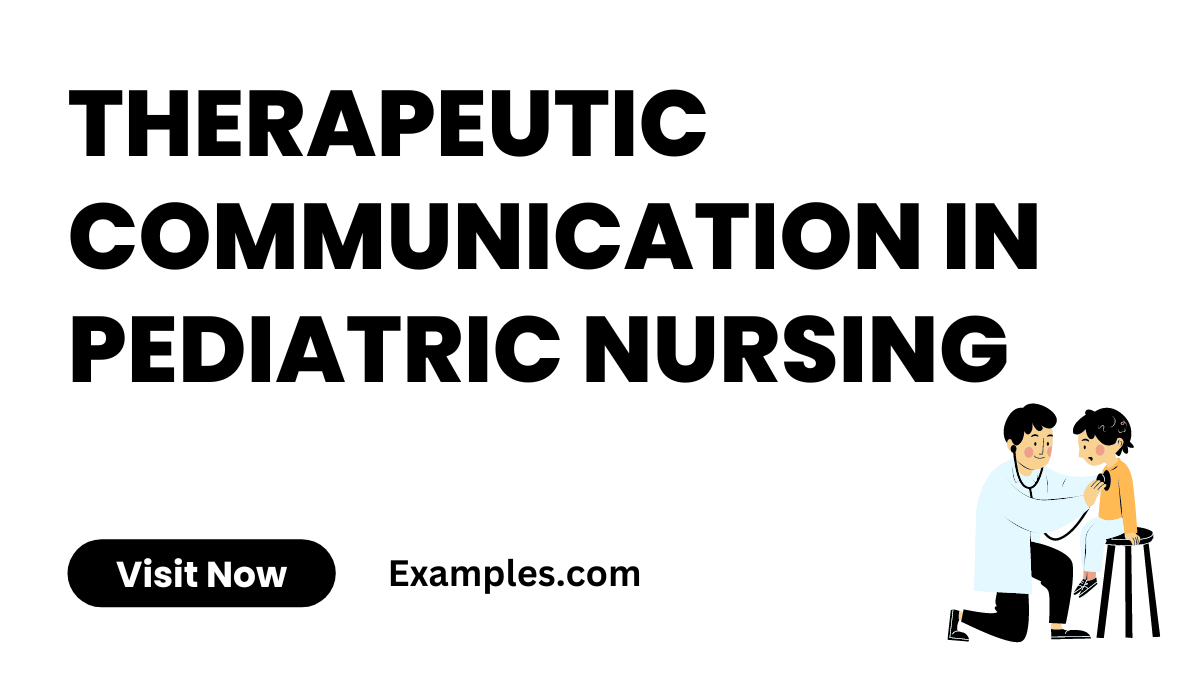29+ Therapeutic Communication in Pediatric Nursing Examples
Therapeutic communication in pediatric nursing is an essential skill that significantly impacts the care and recovery of young patients. It involves using age-appropriate communication techniques and empathetic listening to create a comfortable and trusting environment for children. This guide, complete with practical communication examples, delves into how nurses can effectively communicate with pediatric patients. Understanding the unique needs of children and adapting communication strategies accordingly is crucial in pediatric healthcare settings. Nurses play a pivotal role in easing the anxiety of young patients and their families, making this skill vital for successful pediatric care.
What is Therapeutic Communication in Pediatric Nursing?

Therapeutic communication in pediatric nursing is a specialized form of interaction that nurses use to care for children. It involves using age-appropriate language and techniques to effectively communicate with young patients. This type of communication is tailored to the unique needs of children, making it easier for them to understand and respond to medical care. Nurses use therapeutic communication to comfort, educate, and gather information from pediatric patients. It also includes non-verbal methods like play and visual aids to facilitate understanding. This approach helps in creating a trusting and safe environment, which is crucial for effective pediatric care.
30 Therapeutic Communication in Pediatric Nursing Examples

Therapeutic communication is vital in pediatric nursing, offering a foundation for building trust and understanding with young patients. This guide presents 30 distinct examples, showcasing various approaches and techniques tailored for children’s unique needs in healthcare settings. Each example highlights the importance of empathy, clarity, and age-appropriate interaction, demonstrating how nurses can effectively communicate to ease fears, provide comfort, and deliver care with compassion.
- Using Simple Language: When speaking to a young child, use simple and clear language. For example, “We’re going to listen to your heartbeat now. It will be quick and won’t hurt.”
- Offering Choices: Empower the child by offering choices when possible. “Would you like to hold your teddy bear or my hand while we do this?”
- Validating Feelings: Acknowledge the child’s feelings. “I can see that you’re feeling a bit scared. It’s okay to feel that way.”
- Distraction Techniques: Use distraction during uncomfortable procedures. “Let’s count the colorful fish in the tank while we take your blood pressure.”
- Age-Appropriate Explanations: Provide explanations suitable for the child’s age. “This medicine is like a superhero fighting the germs in your body.”
- Positive Reinforcement: Use positive words and encouragement. “You did a great job staying still for the X-ray!”
- Use of Play: Incorporate play to explain procedures. “Let’s pretend your doll is getting a check-up too.”
- Empathy and Understanding: Show empathy. “I know this is new and might feel strange, but I’ll be with you the whole time.”
- Nonverbal Communication: Utilize comforting nonverbal communication like a gentle touch or a warm smile.
- Asking Open-Ended Questions: Encourage the child to express themselves. “How do you feel about being in the hospital?”
- Creating a Safe Space: Make the child feel safe and secure. “You’re in a safe place where everyone wants to help you feel better.”
- Encouraging Parental Involvement: Involve parents in the conversation. “Can you tell your mom how you’re feeling today?”
- Consistency in Caregivers: Maintain consistency in caregivers when possible. “I’ll be here with you just like yesterday.”
- Providing Comfort Items: Offer comfort items like a blanket or favorite toy.
- Reassurance: Constantly reassure the child. “You’re doing great, and we’re almost done.”
- Explaining Procedures Step by Step: Explain each step before doing it. “First, I’m going to listen to your lungs with this stethoscope.”
- Listening Actively: Show that you’re listening and understanding their concerns.
- Maintaining Eye Contact: Maintain friendly eye contact at the child’s level.
- Respecting Privacy: Respect the child’s privacy and dignity during procedures.
- Patience: Exhibit patience, allowing the child to process information and respond.
- Cultural Sensitivity: Be sensitive to cultural differences in communication.
- Building Rapport: Spend time building rapport before starting any procedure.
- Acknowledging Accomplishments: Acknowledge every small achievement to build confidence.
- Using Analogies: Use analogies and metaphors suitable for the child’s understanding.
- Clarifying Misunderstandings: Clarify any misunderstandings the child may have about the procedure.
- Encouraging Questions: Encourage the child to ask questions about their care.
- Checking for Understanding: Regularly check if the child understands what is being said.
- Speaking Calmly and Slowly: Use a calm and slow tone to avoid overwhelming the child.
- Offering Emotional Support: Offer emotional support throughout the care process.
- Tailoring Communication to Individual Needs: Adjust your communication style to meet the individual needs of each child.
Why is Therapeutic Communication Important in Pediatric Nursing?
Therapeutic communication is vital in pediatric nursing because it helps in building trust and comfort with young patients. By employing child-friendly communication methods, nurses can effectively address the unique emotional and physical needs of children. This approach aids in reducing anxiety and fear in young patients, making them more cooperative during medical procedures. Moreover, effective communication helps in accurately assessing a child’s health condition and needs, leading to better care and treatment.
Establishing Trust
Building trust with pediatric patients is essential. Trust makes children feel safe and secure, encouraging open communication and cooperation during treatment.
Easing Anxiety and Fear
Children often feel scared in medical settings. Therapeutic communication helps in alleviating these fears, making healthcare experiences less intimidating.
Accurate Health Assessment
Clear communication allows nurses to understand a child’s symptoms and concerns better, leading to accurate health assessments and personalized care.
Enhancing Cooperation
When children understand what is happening, they are more likely to cooperate with nurses and doctors, facilitating smoother medical procedures.
Providing Emotional Support
Therapeutic communication also involves offering emotional support to children, helping them to cope with the stress of illness or hospitalization.
What are Therapeutic Communication Techniques in Pediatric Nursing?
Therapeutic communication techniques in pediatric nursing involve various strategies to interact effectively with children. These methods are designed to make children feel comfortable and understood.
Using Age-appropriate Language
Utilizing language that is suitable for the child’s age and understanding is key. This includes simplifying medical terms and using familiar words.
Non-verbal Communication
Employing non-verbal cues like smiling, gentle touch, and playful gestures can make children feel more at ease and understood.
Active Listening
Paying full attention to what the child says and responding thoughtfully shows that their feelings and words are valued.
Visual Aids
Using visual aids like pictures or storybooks helps in explaining medical procedures or conditions in a way that children can easily comprehend.
Play Therapy
Incorporating play into communication helps children express themselves and understand their medical experiences in a comfortable and familiar way.
Tips for Effective Therapeutic Communication in Pediatric Nursing
Effective therapeutic communication in pediatric nursing requires a combination of patience, understanding, and creativity. Here are some tips to enhance communication with young patients.
Be Patient and Empathetic
Understanding that children may take time to express themselves and showing empathy towards their feelings and fears is crucial.
Encourage Expression
Inviting children to talk about their feelings or concerns, and validating their emotions, helps in building a supportive relationship.
Maintain a Positive Attitude
A positive and cheerful demeanor can greatly influence a child’s comfort level and willingness to communicate.
Involve the Family
Involving family members in conversations and care decisions can provide additional comfort and support to the child.
Follow the Child’s Lead
Paying attention to the child’s cues and interests and using them to guide the conversation can make communication more engaging and effective.
In conclusion, therapeutic communication in pediatric nursing is integral to providing effective and compassionate care to young patients. It encompasses a range of strategies, from using age-appropriate explanations to offering emotional support, all tailored to meet the unique needs of children. This approach not only eases the stress of medical procedures for young patients but also fosters a trusting relationship between the nurse and child, crucial for successful pediatric care.
For further insights and resources on this topic, healthcare professionals can explore the American Academy of Pediatrics and the Society of Pediatric Nurses. These platforms provide valuable information and guidance for enhancing therapeutic communication skills in pediatric nursing.



